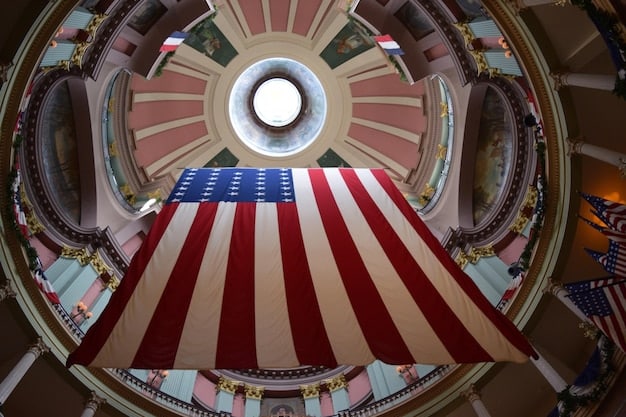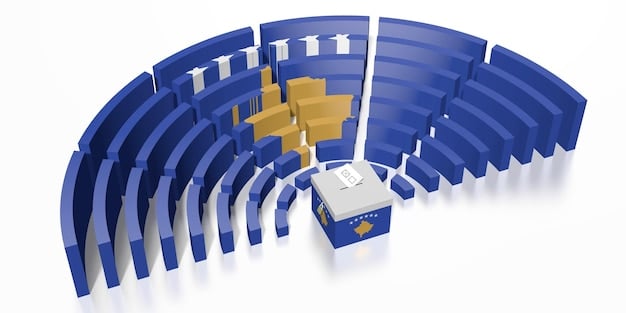The Future of the Filibuster: Will Reforms Pass in Congress?

The Future of the Filibuster: Will Proposed Reforms Pass in the Current Congress? remains contested, with potential changes facing an uphill battle amid partisan divisions, suggesting significant reforms are unlikely to pass imminently.
The filibuster, a procedural tactic in the United States Senate, has long been a subject of debate. Its use and potential reforms have significant implications for the legislative process and the ability of the Senate to address pressing issues. This article explores the future of the filibuster: will proposed reforms pass in the current Congress?
Understanding the Filibuster: A Brief Overview
The filibuster is a procedural tactic used in the United States Senate to delay or block a vote on a bill or other measure. It’s rooted in Senate tradition and requires 60 votes to overcome, known as cloture. This supermajority requirement can effectively gridlock the Senate, making it difficult to pass legislation without bipartisan support.
Historical Context
The filibuster’s origins trace back to the early 19th century when Vice President Aaron Burr advised senators to eliminate the “previous question” motion, which previously allowed a majority to cut off debate. This procedural gap allowed for extended debates that could stall or kill legislation. The first recorded filibuster occurred in 1837.
Modern Usage
In modern times, the filibuster has become a more frequent and potent tool. Senators can signal their intent to filibuster, often leading to negotiations and compromises. However, it can also lead to legislative stagnation, particularly in a deeply divided Congress.

The impact of the filibuster on American politics is profound, influencing the balance of power between the majority and minority parties and shaping the legislative agenda.
- Increased Partisanship: The filibuster often exacerbates partisan divides, forcing compromise or leading to legislative gridlock.
- Legislative Delays: It can significantly slow down the legislative process, preventing timely action on critical issues.
- Power to the Minority: It gives substantial power to the minority party, allowing them to block legislation even if a simple majority supports it.
In conclusion, understanding the history, mechanics, and impact of the filibuster is crucial for grasping its role in contemporary American politics. It is a tool used to shape policies and can have a polarising impact; and its potential reforms are a subject of heated debate.
Arguments For and Against the Filibuster
The debate over the filibuster is polarized, with strong arguments both for and against its continued use. Proponents argue it protects minority rights and promotes consensus, while opponents contend that it obstructs the will of the majority and leads to legislative dysfunction.
Arguments in Favor
Supporters of the filibuster argue that it serves as a crucial check on the power of the majority, preventing them from enacting sweeping changes without broad support. It ensures that the voices of all states and viewpoints are heard.
- Protection of Minority Rights: The filibuster ensures that the minority party has a voice and can prevent the majority from steamrolling their agenda.
- Promotion of Bipartisanship: It encourages compromise and negotiation, leading to legislation that is more likely to garner broad support.
- Prevention of Radical Legislation: It acts as a safeguard against radical or poorly considered legislation that may not have widespread support.
Arguments Against
Critics of the filibuster argue that it is an outdated and undemocratic tool that obstructs the will of the majority and leads to legislative gridlock. It creates a system where a minority can effectively block the passage of popular legislation.
- Obstruction of the Majority Will: The filibuster allows a minority of senators to block legislation supported by a majority of the Senate and the American people.
- Legislative Gridlock: It contributes to legislative gridlock and prevents the Senate from addressing pressing issues in a timely manner.
- Undemocratic Nature: Critics argue that it is undemocratic to allow a minority to obstruct the will of the majority.
The arguments surrounding the filibuster reflect fundamental differences in political philosophy and views on the role of the Senate in American democracy. Both sides present compelling points, highlighting the complexity of the issue.
Proposed Reforms to the Filibuster
Over the years, numerous reforms to the filibuster have been proposed, ranging from modest adjustments to wholesale changes. These proposals aim to address the perceived problems with the filibuster while preserving its role in protecting minority rights and promoting consensus.

Lowering the Vote Threshold
One common proposal is to lower the number of votes required to invoke cloture, the procedural mechanism to end a filibuster. Some suggest lowering the threshold from 60 to 55 or even 51 votes.
Eliminating the Filibuster Entirely
The most radical proposal is to eliminate the filibuster altogether, allowing a simple majority to pass legislation. This would align the Senate’s rules more closely with those of the House of Representatives, where a simple majority is typically sufficient to pass bills.
“Talking Filibuster”
Another proposal is to return to the traditional “talking filibuster,” which required senators to physically hold the floor and continuously speak in order to delay a vote. This would make filibusters more difficult and less frequent, as it would require senators to make a greater effort to obstruct legislation.
- Potential Impacts of Reforms: Various reforms to the filibuster can greatly alter the Senate’s legislative processes. If reforms are implemented, its effects could be profound.
- Increased Efficiency: Many proponents argue that lowering the vote threshold would facilitate smoother legislative proceedings and enable the Senate to tackle urgent matters more swiftly.
- Shift in Power Dynamics: Removing the filibuster could significantly alter the power balance in the Senate, potentially diminishing the influence of smaller states and rural voters.
Proposed reforms to the filibuster represent a spectrum of ideas, each with its own potential consequences for the Senate and American politics. The debate over these reforms is likely to continue as long as the filibuster remains a central feature of the legislative process.
The Role of Party Politics in Filibuster Reform
Party politics play a significant role in the debate over filibuster reform. The party in power often seeks to limit or eliminate the filibuster to advance its legislative agenda, while the minority party typically defends it as a tool to protect its interests.
Democratic Positions
In recent years, many Democrats have become increasingly critical of the filibuster, arguing that it obstructs progress on key issues such as voting rights, climate change, and healthcare. Some have called for its elimination, while others have supported more modest reforms.
Republican Positions
Republicans have generally defended the filibuster as a crucial check on the power of the majority and a tool to protect minority rights. However, some Republicans have also expressed frustration with the filibuster when they are in the majority and seeking to advance their own legislative agenda.
- Political Calculations: The perspective on filibuster reform is susceptible to the fluctuating dynamics of the political landscape, wherein both Democrats and Republicans might recalibrate their stances predicated on their status in the majority or minority.
- Impact of Presidential Elections: Presidential outcomes heavily influence the trajectory of filibuster reform, particularly when the legislative and executive branches are under the authority of opposing parties, thereby intensifying the potential for gridlock.
- Future Implications: The forthcoming trajectory of filibuster reform will be deeply affected by the constantly shifting alignments of political parties, underscoring the intricacies of steering legislative changes in a setting marked by intense divisions.
The role of party politics in the filibuster debate highlights the challenges of achieving meaningful reform. Any changes to the filibuster are likely to be fiercely contested along partisan lines. Therefore, it is essential to consider the impact of political considerations when discussing filibuster reform.
Historical Attempts at Filibuster Reform
Throughout its history, there have been numerous attempts to reform the filibuster, with varying degrees of success. These efforts reflect ongoing concerns about the filibuster’s impact on the Senate and the legislative process.
Rule XXII: Cloture
In 1917, the Senate adopted Rule XXII, which allowed for cloture, a mechanism to end a filibuster. Initially, the rule required a two-thirds vote to invoke cloture. However, it was rarely used in the early years.
Lowering the Cloture Threshold
In 1975, the Senate lowered the cloture threshold from two-thirds to three-fifths (60 votes). This change made it somewhat easier to end filibusters, but it still required a supermajority.
- Failed Reform Attempts: Multiple initiatives aimed at filibuster reform have struggled to gain momentum, underscoring the entrenched interests and deep-seated partisan divides that impede comprehensive modifications to Senate regulations.
- Historical Milestones: Amidst recurrent stalemates, notable instances of achievement underscore human ingenuity and determination in surmounting seemingly insurmountable obstacles, thus paving the path for societal advancement and constructive transformation.
- Lessons Learned: Examining historical reforms, both successful and unsuccessful, provides invaluable perspectives for policymakers considering future modifications to the filibuster, emphasizing the significance of bipartisanship, compromise, and strategic timing.
Despite these historical attempts at reform, the filibuster remains a contentious issue in the Senate. The ongoing debate over its future reflects the enduring challenges of balancing minority rights and the need for effective governance.
The Future of the Filibuster in the Current Congress
Looking ahead, the future of the filibuster in the current Congress remains uncertain. Given the narrow Democratic majority in the Senate and the deep partisan divisions, it is unlikely that any major reforms will be enacted in the near future.
Obstacles to Reform
Several factors stand in the way of filibuster reform. First, there is significant opposition from Republicans, who are unlikely to support any changes that would weaken their ability to block Democratic legislation.
Potential Compromises
Despite these obstacles, there may be some room for compromise on modest reforms. For example, some senators have suggested creating exceptions to the filibuster for certain types of legislation, such as voting rights or campaign finance reform.
Ultimately, the future of the filibuster in the current Congress will depend on the willingness of both parties to engage in good-faith negotiations and find common ground. While major reforms are unlikely, there may be opportunities for incremental changes that could improve the functioning of the Senate.
- Short-Term Outlook: Considering the current political climate, comprehensive reforms to the filibuster appear improbable, highlighting the challenges of achieving bipartisan agreement on substantial procedural modifications amidst partisan disagreements.
- Long-Term Possibilities: Over the long term, shifts in demographics, political alignments, and public sentiment may pave the way for a renewed emphasis on filibuster reform, reflecting the fluidity of American politics and the adaptability of its legislative procedures.
- Impact on Governance: The prospective trajectory of the filibuster carries profound ramifications for the efficacy of governance, potentially shaping the Senate’s capacity to tackle pressing issues, address constituent needs, and uphold public confidence in governmental institutions.
| Key Point | Brief Description |
|---|---|
| 🏛️ Filibuster Defined | A Senate tactic to delay or block a vote. |
| ⚖️ Pro & Con | Protects minority vs. obstructs majority will. |
| 🔄 Reform Ideas | Lower vote threshold, eliminate, “talking” filibuster. |
| 🔮 Current Outlook | Major reforms unlikely due to partisan divisions. |
Frequently Asked Questions
▼
The filibuster is intended to protect minority rights in the Senate by requiring a supermajority (60 votes) to end debate on most legislation, preventing a simple majority from pushing through bills without broader consensus.
▼
The filibuster is controversial because it can lead to legislative gridlock, allowing a minority of senators to block popular legislation and obstruct the will of the majority, leading to frustration and inaction.
▼
Proposed reforms include lowering the cloture threshold to a simple majority, eliminating the filibuster entirely, or requiring senators to physically hold the floor to delay a vote through a “talking filibuster.”
▼
Party politics heavily influence the filibuster debate, with the party in power often seeking to limit it to advance their agenda, while the minority party defends it to protect their interests and block opposing legislation.
▼
Given the narrow Democratic majority in the Senate and strong Republican opposition, it is unlikely that major filibuster reforms will pass in the current Congress, though some incremental changes remain possible.
Conclusion
In conclusion, the filibuster remains a crucial element of the American legislative process that has significant political consequences. While substantial change appears unlikely in the current political context, it is vital to acknowledge that there is still a role for potential adjustments that might enhance the efficiency of the Senate while preserving meaningful checks on authority.





